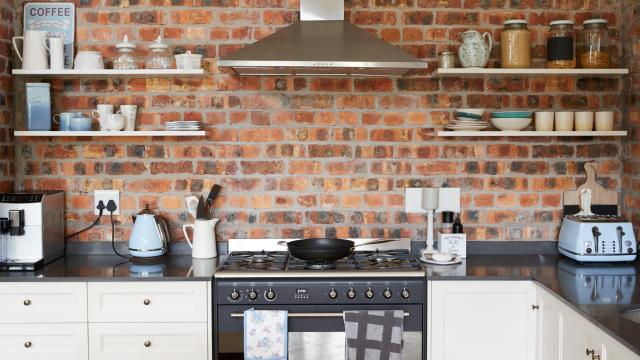Brick is a hardy, durable building material that conveys a sense of classic design and old-school charm. At the same time, it’s super tough and requires relatively little maintenance. That makes brick desirable for folks who are house-hunting, and also makes exposing brick walls inside your house almost irresistible to some people.
But as strong as brick is in its role as a building material, it’s not impervious and it does require some maintenance if it’s exposed to weather or even the inside of your house. As anyone who has ever triumphantly exposed some brick in their house only to hear a sad trombone in the distance as they reveal a crumbling, collapsing heap of bricks behind the drywall, brick can — and will — fail you.
Brick can start to crumble and visibly deteriorate; but while crumbling is one sign that your brick needs some TLC, it doesn’t necessarily mean you need to replace it. Here’s when to worry about your brick wall.
Efflorescence
Often the first sign that your brick has a problem is efflorescence — a white dusting on your brick’s surface. This is the result of moisture getting into the brick and leeching out salts, then drying on the surface and leaving the salt behind. That moisture could be coming from the weather outside, or a leak inside your house — step one will always be to identify where the water is coming from and deal with it. But efflorescence is an early warning sign. As long as you deal with the moisture issue and any damage you see on the brick, you should be OK.
Missing mortar
Another sign that your brick is screaming for some help is missing mortar — the adhesive cement-like stuff between the bricks that holds everything together. Mortar is generally not as strong as brick, and in exposed brick, it will need to be replaced periodically (typically about every 15-20 years, depending on environmental conditions). If you’ve ignored your brick and the mortar is falling out or crumbling but the bricks themselves seem fine, you probably just need to re-point your brick.
Spalling
If your brick is crumbling visibly, you have bigger problems. The crumbling is known as “spalling,” and it’s a bad sign that your brick wall has been getting soaked with moisture for a long time (or was installed incorrectly in the first place). When that moisture freezes, it expands and damages the structure of the brick. Over time, the brick stops being a brick and turns into a collection of dust.
Spalling is a bad sign, but if caught early enough, it’s possible to arrest the process and repair spalling brick — again, this starts with figuring out how the water is getting in there and dealing with it. If there’s no source that can be re-directed or sealed up, you should plan to seal the brick well after you’ve made some repairs.
Bowing & diagonal cracks
Finally, if your brick is not just crumbling but also bowing outward (or inward) or shows diagonal cracks around windows and doors, it probably can’t be saved. That likely means the structural integrity of the brick is failing, and it’s only a matter of time before it finishes the process in spectacular fashion. A professional mason may have some ideas about salvaging the situation, but you should definitely worry.

Leave a Reply
You must be logged in to post a comment.